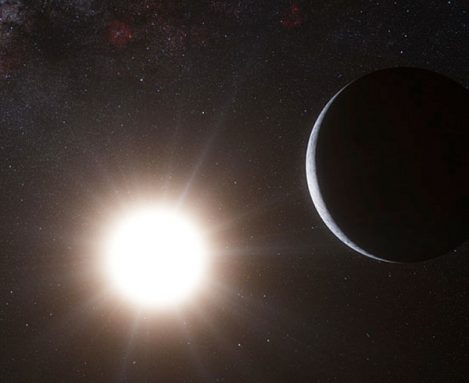New planetary neighbor
Nearest star system has a world that's Earthly in size, but too hot for human visitors

For decades, astronomers have been training telescopes all over the sky, looking for alien worlds. In October, they reported finding an Earth-sized planet near a small, next-door star. The discovery naturally raises the question: When can we visit?
“A rocky planet around … our nearest neighbor — this is incredible,” planet-hunting astronomer Debra Fischer told Science News. The Yale University scientist did not work on the new study. “If you were going to send a spacecraft anywhere, or a probe anywhere, that’s where you’d go first.”
The planet’s star, Alpha Centauri B, is a little smaller and cooler than the sun. It and a larger star called Alpha Centauri A sit about 4.4 light-years away, roughly the distance of 150,000 round trips from Earth to the sun. That may seem far away, but the Alpha Centauri system is our nearest stellar neighbor.
A year on the newfound rocky exoplanet — or planet outside the solar system — lasts a little over three days. And while its size may seem familiar, its climate leaves a lot to be desired. It orbits its star so closely that the temperature on the exoplanet’s surface is around 1,200 degrees Celsius (about 2,200 degrees Fahrenheit), notes astronomer Greg Laughlin of the University of California, Santa Cruz. That’s hotter than the melting point of gold — and means life probably doesn’t stand a chance there.
“It’s utterly uninhabitable, utterly scorched, utterly un-Earthlike in every respect,” he told Science News.
It is possible that the same side of the planet always faces the star, which means the side of the planet farthest from the star would be cooler.
The planet’s existence suggests there may be more planets orbiting the same star. Previous studies have shown that Alpha Centauri B doesn’t have gas giants, like Jupiter or Saturn, orbiting it. But it may have more of those small rocky worlds — even some that are farther from the star, and therefore likely cooler.
Astronomer Stéphane Udry of the University of Geneva in Switzerland helped discover the new planet. His team used an instrument on a 3.6-meter (nearly 12-foot) telescope atop a mountain in Chile. The instrument, called HARPS, scans the skies to find stars that wobble from the gravitational pull of a nearby planet. They reported their new discovery October 18 in the journal Nature.
Udry told Science News that his group wasn’t surprised to find the planet.
“We know now that these planets are everywhere,” Udry said. “The question is, how big, how far from the star? That’s what we are trying to characterize.”
Power Words
exoplanet A planet outside the solar system.
orbit The curved path of a celestial object or spacecraft around a star.
light-year The distance traveled by light in one year, nearly 6 trillion miles.
gravity The force that attracts any body with mass, or bulk, toward any other body with mass. The more mass there is, the more gravity there is.







